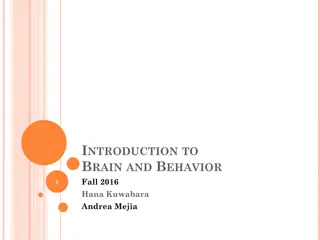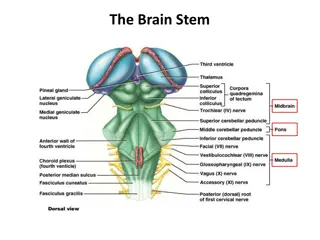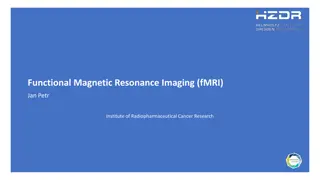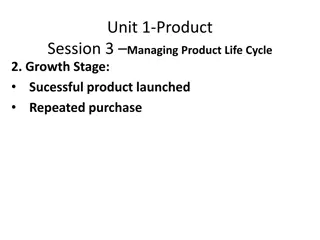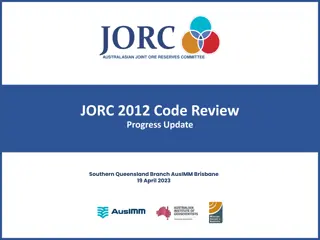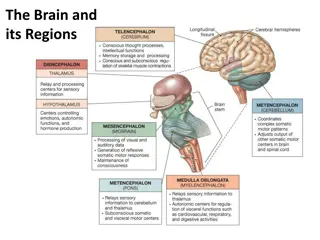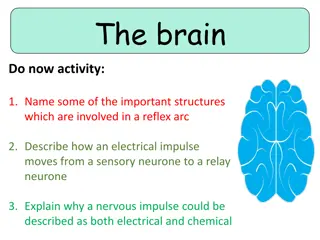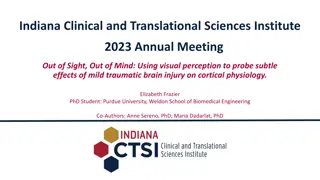Brain Mineral Deposition and Cognitive Decline Study
Investigating the progression pattern of brain mineral deposition as a differential indicator of cognitive decline in individuals with varying cognitive statuses from normal to Alzheimer's disease. The study aims to develop improved imaging techniques and specific cognitive-relevant atlases to understand the distribution of mineral deposits and their impact on cognitive function. Utilizing advanced MRI data analysis and software tools, the research focuses on identifying distinctive patterns in mineral deposition associated with cognitive decline stages.
Download Presentation
Please find below an Image/Link to download the presentation.
The content on the website is provided AS IS for your information and personal use only. It may not be sold, licensed, or shared on other websites without obtaining consent from the author. Download presentation by click this link. If you encounter any issues during the download, it is possible that the publisher has removed the file from their server.
Presentation Transcript
Progression pattern of brain mineral deposition as a differential indicator of cognitive decline L. Clayson1, M.C. Vald s Hern ndez2, A. Glatz2, J.M. Wardlaw2, J. Starr3 1College of Medicine and Veterinary Medicine, University of Edinburgh, Edinburgh, UK. 2 Centre for Clinical Brain Sciences, Department of Neuroimaging Sciences, University of Edinburgh, Edinburgh, UK 3Centre for Cognitive Ageing and Cognitive Epidemiology, University of Edinburgh, UK
Background Image: L Clayson, mechanisms as reviewed in Moreno-Trevino et al 2015
Background Brain glial cell regulation of iron Neurone Glial cell Ceruloplasmin bMVECs Hepcidin FPN Blood vessel Iron Image: L Clayson. Schematic representation of brain iron regulation mechanisms (as detailed in McCarthy & Kosman 2014). [FPN: Ferroportin, bMVECS: brain microvascular endothelial cells].
Background Image: L Clayson. Schematic representation of mineral deposition mechanisms
Hypotheses 1. There is a distinctive pattern of mineral deposition depending on the cognitive status (CN, MCI or AD) of patients 2. With cognitive decline, mineral deposition increases in regions know to be associated with increased amyloid deposition
Aims To investigate the prevalence of basal ganglia mineral deposition (BGMD) and brain microbleeds in individuals of cognitive status ranging from CN to AD To improve our imaging techniques by developing a specific cognitively-relevant atlas of the distribution of mineral deposits with estimates of the main mineral content per region.
Ultimately.. Is there a progression pattern of brain mineral deposition that can be used as a differential indicator of cognitive decline?
Methods ADNI Database Selection Criteria: Sample 1: M.R.I. FLAIR, T2* & MPRAGE for 3 years Sample 2: MRI data for 1 year
Methods (2) Semi-Automatic Software: - Analyze 11.0, MRIcron BGMD Measurements - Automatic Pipeline (Glatz et al, 2015) Microbleed Visual Assessments
Methods (3) Following blinded assessments, cognitive status was recorded Patient Cognitive Status Assessment CN EMCI LMCI AD MMSE Score 24-30 24-30 24-30 20-26 CDR (Clinical Dementia Rating) 0.0 0.5 0.5 0.5/1.0 Wechsler Memory Scale Logical Memory II 16 years: 9 8-15 years: 5 0-7 years: 3 16 years: 9-11 8-15 years: 5-9 0-7 years: 3-6 16 years: 8 8-15 years: 4 0-7 years: 2 16 years: 8 8-15 years: 4 0-7 years: 2
Results Longitudinal Analysis Sample 1 microbleeds: 18 16 14 12 Microbleed Count 10 8 6 4 2 0 Y1 Y2 Y3 Time Point
SAMPLE 1: Image analysis of microbleeds Probability Atlas of microbleed distribution by cognitive group Red indicates areas prominently affected
Results Total B.G. Mineral deposition 1200 Sample 1: Progression of Total BGMD Volume 1000 Total BGMD Volume 800 600 400 200 0 Y1 Y2 Y3 Timepoint
BGMD Progression by Cognitive Status + Predominant Iron and Calcium
SAMPLE 1: Image analysis of total BGMD Cognitively Relevant atlas of mineral deposition
Results Cross Sectional Study Sample 2: Microbleed Prevalence
Results Cross Sectional Study Sample 2: Total BGMD followed the same pattern as the sample 1
SAMPLE 2: Image analysis of total BGMD
Discussion Lack of association between microbleeds and cognitive decline in AD (van der Vlies et al, 2012) Microbleeds increase in AD (Yates et al 2014) Insignificant BGMD results (Vald s Hern ndez et al 2012) Similar pattern in serum and CSF (Lavados et al 2008, Mueller et al 2012) Validation method showed ageing > TG alteration (Park et al, 2014) Power, Protocols, Risk Factors, Cognitive Decline
Conclusions Increased mineralisation and microbleed load amongst patients from CN to LMCI and gradual decrease towards AD could be of potential use as a differential indicator in the diagnosis of AD LMCI EMCI AD CN
Conclusions Microbleeds and BGMD may be useful indicators of mild cognitive impairment. Need to replicate this study in a larger sample + follow progression over a longer time period. Do microbleeds/BGMD disappear when LMCI patients progress to AD/ if so why?
References Glatz A, Bastin ME, Kiker AJ, Deary IJ, Wardlaw JM, & Hern ndez MCV (2015). Automated segmentation of multifocal basal ganglia T2*-weighted MRI hypointensities. NeuroImage 105, 332- 346. Lavados M, Guill n M, Mujica MC, Rojo LE, Fuentes P, Maccioni RB (2008). Mild cognitive impairment and Alzheimer patients display different levels of redox-active CSF iron. J Alzheimers Dis 13(2), 225-32. Mueller C, Schrag M, Crofton A, Stolte J, Muckenthaler MU, Magaki S, Kirsch W (2012). Altered serum iron and copper homeostasis predicts cognitive decline in mild cognitive impairment. J Alzheimers Dis29(2), 341-50. Park L, Koizumi K, El Jamal S, Zhou P, Previti ML, Van Nostrand WE, Carlson G, Iadecola C (2014). Age-dependent neurovascular dysfunction and damage in a mouse model of cerebral amyloid angiopathy. Stroke 45(6),1815-21. Vald s Hern ndez Mdel C, Maconick LC, Tan EM & Wardlaw JM (2012). Identification of mineral deposits in the brain on radiological images: a systematic review. EurRadiol22(11), 2371-81. van der Vlies AE, Goos JD, Barkhof F, Scheltens P, van der Flier WM (2012). Microbleeds do not affect rate of cognitive decline in Alzheimer disease. Neurology 79, 763 769 Yates PA, Desmond PM, Phal PM, Steward C, Szoeke C, Salvado O, Ellis KA, Martins RN, Masters CL, Ames D, Villemagne VL, Rowe CC & AIBL Research Group (2014). Incidence of cerebral microbleeds in preclinical Alzheimer disease. Neurology82(14), 1266-73
Validation Images: L Clayson, MV Hern ndez




